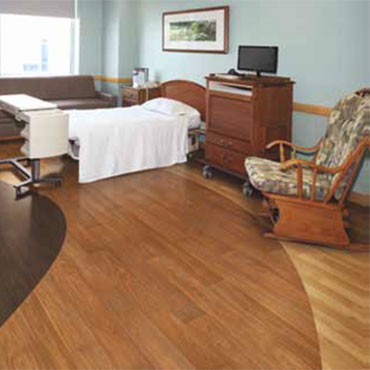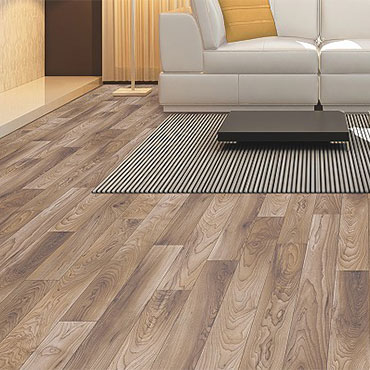Mannington Vinyl Floors prove that vinyl flooring can be both surprisingly fashionable and indisputably durable. Learn More
Sheet Vinyl Flooring
Sheet Vinyl Flooring Guide

Is Your Flooring Hurting Your Bottom Line? Discover the Benefits of Sheet Vinyl Flooring
Business owners, property managers, and facility managers face tough decisions when it comes to infrastructure investments, particularly flooring. The wrong choice can lead to costly repairs, high maintenance fees, or even tenant dissatisfaction. Sheet Vinyl Flooring offers a solution that combines cost-efficiency, durability, and aesthetic appeal—all while being easy to maintain. This resilient flooring is designed for professionals who need a product that balances quality with budgetary constraints.
What is Sheet Vinyl Flooring?
Sheet vinyl flooring is a resilient, flexible material often used as a cost-effective alternative to natural stone, ceramic tile, or hardwood. It comes in large, continuous rolls, customized to fit any space. Known for its water-resistant properties, it’s an ideal choice for moisture-prone areas like kitchens and bathrooms. With its layered construction and protective finishes, sheet vinyl flooring is not only durable but also available in a wide range of realistic designs that mimic natural stone, wood, and tile.
Features and Benefits of Sheet Vinyl Flooring
- Cost-Efficient: Sheet vinyl is one of the most budget-friendly flooring options, providing excellent value without sacrificing quality.
- Waterproof: Its single solid surface is impervious to water, making it perfect for areas exposed to moisture.
- Durable and Long-Lasting: Layered construction and a protective wear layer ensure that this flooring holds up well under heavy foot traffic and daily wear.
- Low Maintenance: Easy to clean and resistant to stains, sheet vinyl reduces the cost and time required for upkeep.
- Comfortable Underfoot: Some sheet vinyl flooring features cushioned layers, offering a softer, more comfortable walking surface.
- Aesthetic Versatility: With advances in print technology, sheet vinyl now offers highly realistic textures and visuals that resemble hardwood, stone, and tile.
Why Sheet Vinyl Flooring Stands Out
Sheet Vinyl Flooring distinguishes itself from other vinyl and resilient flooring options through its seamless design and enhanced durability. Unlike vinyl planks or tiles, which can have seams where water can penetrate, sheet vinyl is a continuous, waterproof surface that provides better protection against moisture. Its recent advancements in printing technology have led to more realistic designs, whether you’re looking for a traditional hardwood look or modern stone patterns. This combination of design flexibility, low cost, and high durability makes it a superior choice in the resilient flooring category.
Most Appropriate Spaces for Sheet Vinyl Flooring
Sheet vinyl flooring is highly versatile and can be installed in a wide range of environments:
- Kitchens and Bathrooms: Thanks to its waterproof qualities, it excels in areas prone to spills and humidity.
- Laundry Rooms: Its durability and moisture resistance make it ideal for laundry spaces, where leaks and high humidity can be an issue.
- Commercial Spaces: In offices, retail areas, or even warehouses, sheet vinyl’s durability and low maintenance make it a practical choice for high-traffic environments.
- Healthcare and Educational Facilities: With its easy-to-clean surface and comfort underfoot, sheet vinyl is frequently used in hospitals, schools, and other institutional settings.
Why Business Professionals Choose Sheet Vinyl Flooring
For business owners, property managers, and facility managers, sheet vinyl flooring offers a solution that aligns with key priorities such as cost-efficiency, durability, and long-term performance. Its minimal maintenance requirements and long lifespan contribute to lower operating costs, while its wide range of designs ensures that it can fit the aesthetic and functional needs of any space. Additionally, sheet vinyl meets safety and compliance standards, ensuring that your flooring contributes to a secure, professional environment.
Invest in the Future of Your Property with Sheet Vinyl Flooring
With its unbeatable combination of durability, aesthetic appeal, and cost-efficiency, sheet vinyl flooring provides an ideal solution for professionals seeking to maximize value while minimizing hassle. Whether you’re managing a commercial property, overseeing a residential complex, or maintaining an industrial facility, sheet vinyl flooring ensures long-term performance and satisfaction.
Sheet Vinyl Flooring: A Durable, Cost-Efficient Solution for Business and Property Management
Disclaimer: The information provided in this article is for general informational purposes only. While we strive to ensure the accuracy and reliability of the information presented, we make no warranties, express or implied, about the completeness, accuracy, reliability, suitability, or availability with respect to the content. Any reliance you place on such information is strictly at your own risk. We recommend consulting with professionals for specific advice tailored to your project’s needs, particularly regarding building codes, regulations, and product specifications.
Under no circumstances shall we be liable for any loss or damage, including without limitation, indirect or consequential loss or damage, arising from the use of, or reliance on, the information provided in this article.
Select Product Sub-Category:
Sheet Vinyl Flooring
Top 3 Types of Sheet Vinyl Flooring
 Vinyl/Resilient - 169 Inlaid Vinyl (sheet) FlooringDiscover the elegance and durability of Inlaid Sheet Vinyl Flooring, a versatile choice for designers and decorators, offering seamless beauty and long-lasting performance. Learn More | |
 Vinyl/Resilient - 167 Cushioned Vinyl FlooringExplore Cushioned Vinyl Flooring, the perfect blend of comfort, style, and durability for interior designers and decorators. Ideal for high-traffic areas and moisture-prone spaces. | |
 Vinyl/Resilient - 175 Homogeneous Vinyl FloorsDiscover homogeneous vinyl floors—durable, sustainable, and perfect for commercial spaces. Ideal for high-traffic environments like hospitals and retail stores. |
Featured Brands
The Best 5 Sheet Vinyl Flooring Brands


Tarkett Sheet Vinyl Flooring
Profile | Website | Design Tools | Warranty | GreenVinyl sheet flooring combines a broad portfolio of patterns and colorways with high performance for schools, hospitals and other high traffic areas. From heterogeneous sheet composed of several layers, including a printed sheet for limitless design possibilities. Learn More

Johnsonite Sheet Vinyl Flooring
Profile | Website | Install | Maintain | GreenAcczent Wood Safe-T flooring gives a natural wood look plus slip resistance. This distinct composition also makes the floors easier to maintain, which means greater return on your investment. Available in four coordinating colors to Acczent Wood, Acczent Safe-T is ideal for housing, healthcare, school and retail environments. Learn More

Mohawk Sheet Vinyl Flooring
Profile | WebsiteLuxury vinyl flooring is soft underfoot, easy to clean, and water resistant, making it a great choice for kitchens and areas that see a lot of action. Learn More

Kraus Luxury Vinyl Floors
Profile | WebsiteWe are proud that, through the efforts of our employees, Kraus' main carpet and fiber manufacturing facilities in Waterloo, Ontario have developed a quality manufacturing system dedicated to continual process improvement. Learn More
Sheet Vinyl Flooring News
Latest Sheet Vinyl Flooring News
Inlaid Vinyl (sheet) Flooring...iers, and Consultants NeedIn today's fast-paced building industry, professionals are constantly searching for materials that deliver both design excellence and practical durability. Inlaid Sheet Vinyl Flooring stands out as a versatile, resilient flooring solution designed to meet the high standards of architects, specifiers, and building consultants. Combining a perfect balance of aest... |
Sheet Vinyl Flooring...nd aesthetic appeal. Whether you’re a business owner looking for cost-effective flooring, a property manager overseeing tenant satisfaction, or a facility manager responsible for building operations, Sheet Vinyl Flooring offers a reliable solution. This highly versatile flooring option not only meets functional needs but also offers durability and style, making it an excellent investment for long-... |




